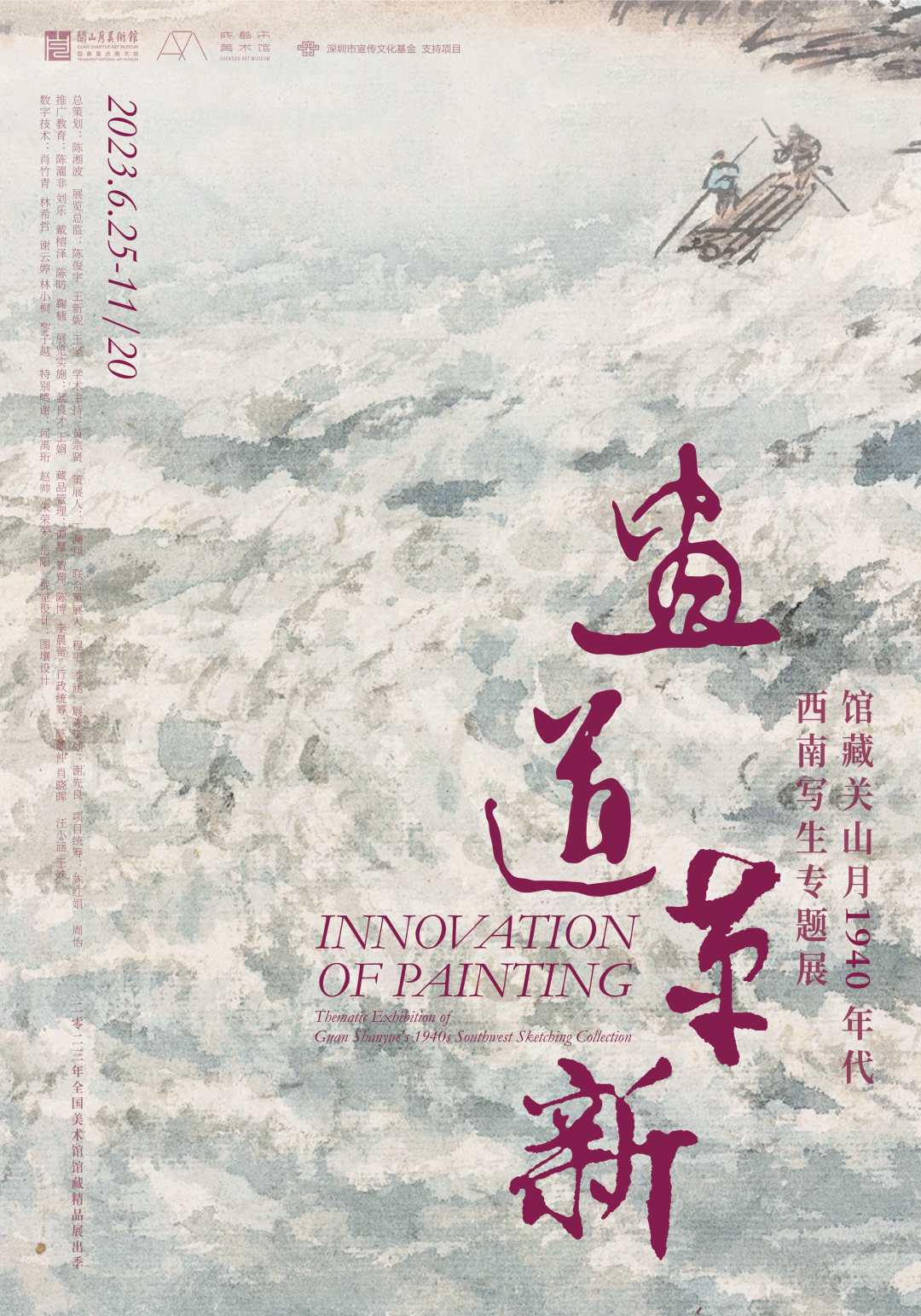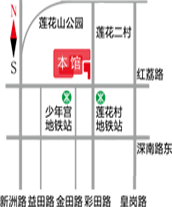
- Renovation of Painting Path - Southwest Sketching Exhibition of Guan Shanyue in the 1940s
-

Click to view Organizer: Shenzhen Guan Shanyue Art Museum
Co organizer: Chengdu Art Museum
Exhibition location: Exhibition Hall on the Second Floor of Shenzhen Guan Shanyue Art Museum
Exhibition period: June 25th, 2023- November 20th, 2023
Chief planner: Chen Xiangbo
Exhibition Director: Chen Junyu, Wang Xinni, Wang Jian
Academic host: Huang Zongxian
Curator: Ding Lanxiang
Co curator: Cheng Ping and Li Han
Exhibition Planning: Xie Xianliang
Project coordinator: Chen Hongjuan and Zhou Yi
Promotion Education: Chen Zhuofei, Liu Le, Dai Rongze, Chen Fang, Ju Nan
Exhibition implementation: Lan Liangcai, Wang Juan
Collection management: Tan Hui, He Xiang, Chen Bo, Li Chenlei
Administrative coordination: Chen Qizhong, Xiao Xiaohui, Wang Xiaohan, and Wang Shu
Digital technology: Xiao Zhuqing, Lin Xizhe, Xie Yunting, Lin Xiaotong, Li Ziyue
Special thanks: He Yuheng, Zhao Shuai, Zhu Rongrong, Yueyang
Visual design: Togrow Art Design(TGAD)
Preface to Traditional Chinese Painting - Sketching from Life
The term "sketching" in modern terms was misappropriated by the Qing government from Japanese education laws and regulations. It was not until several years later that this method of "physical sketching" was brought into China by Japanese students. The concept of "sketching" at this time was closer to the concept of "sketching" in Japan from Meiji to modern times, that is, "physical sketching" or "painting of physical objects". In 1918, Cai Yuanpei gave a speech at the Peking University Painting Research Association, linking "sketching" with "science": "Westerners value natural science, so art also starts with describing objects." Under the influence of Cai Yuanpei's aesthetic education concept, sketching activities in domestic art schools quickly spread, and Chinese painters gradually accepted and applied sketching techniques.
Chapter 1 Initial Exploration of the Shu Road
In April 1941, Guan Shanyue continued to implement the plan of traveling thousands of miles and left Guilin to arrive in Chongqing via Guiyang. On May 1st, the Guan Shanyue Painting Exhibition was previewed at the Central Library and officially opened on the 2nd. Exhibiting anti Japanese war paintings and works from Guangxi and Guizhou. At the exhibition, Guan Shanyue met Zhao Wangyun, who was also in the period of artistic transformation. The two became good friends at first sight and went together to sketch in the Guanxian and Qingcheng areas. Influenced by Zhao Wangyun's concept of sketching, Guan Shanyue preserved the on-site information of the sketches to the greatest extent possible during her creation, which is a transformation of traditional Chinese painting sketching.
Chapter 2 The Life of Miao Compatriots
In July 1941, Guan Shanyue left Sichuan and went to Guiyang to hold an exhibition, then returned to Guilin. At the end of the year, Guan Shanyue held his third solo exhibition in Guilin, with his works mostly depicting rural life in Southwest China, showcasing his innovative painting techniques of going deep into the folk and exploring life. At the end of 1941, Guan Shanyue and Zhao Wangyun teamed up again to Guiyang for sketching. From the comparison between Guan Shanyue's sketching works in Guiyang and Zhao Wangyun's sketching, it is not difficult to find that he was influenced by Zhao Wangyun's rural sketching, and his sketching style was more direct, intuitive, and closer to the people.
Chapter 3 Songyashan City
In the autumn of 1942, Guan Shanyue entered Sichuan again from Kunming via the Minjiang River and arrived in Chengdu. Recommended by Zhao Wangyun, he resided in the French Ruibi Alumni Association in Duyuan Street and sketched around during the period. In December, Guan Shanyue and Zhao Wangyun went to the Chongqing Sino Soviet Cultural Association to hold an exhibition. Zhao's works were mostly northwest travel sketches, while Guan presented the life of Miao people and rural sketches. Guo Moruo went to visit and wrote a poem and postscript for the "Songya Mountain City Map" co authored by Guan and Zhao, praising: "Wang Yun and Shanyue are the new leaders of traditional Chinese painting, with a solid style that is not confined by old methods. They strive to break through the barriers of traditional painting materials and focus on depicting modern folk customs, which is powerful enough." In May 1943, Guan Shanyue and his wife went to the northwest to sketch, passing through Xi'an, Lanzhou, and the Hexi Corridor to reach Dunhuang. After three months of painting in Dunhuang, they entered Qinghai to sketch again. In this extraordinary journey of sketching, Guan Shanyue gained a visual experience completely different from the Lingnan region. The unique style of Dunhuang murals, the magnificent northwest scenery, and the peculiar customs of multiple ethnic groups injected new vitality into his works.
Chapter Four: Sketching in Bashu
In March 1944, Guan Shanyue returned from Qinghai to Chengdu and began holding exhibitions and painting there. In autumn, I went on a trip to Leshan and Zigong to sketch from life. On January 13, 1945, Guan Shanyue held the "Northwest Journey Painting Exhibition" at the Sino Soviet Cultural Association. There were reports indicating that the exhibition's content was "not about romance, but about reality.". Guo Moruo wrote a poem praising Guan Shanyue for "breaking through elegance in the reform of painting, and seeking truth in the folk style.". On May 20, 1946, Guan Shanyue held the "Ten Thousand Li Map of Guanshan" art exhibition at the Chongqing Sino Soviet Cultural Association. After the exhibition, Guan Shanyue and his wife immediately set off from Chongqing to return to Guangdong. At this point, the writing activities of Guan Shanyue in the Southwest region in the 1940s have come to an end.
Epilogue
After returning to Guangdong from Chengdu, Guan Shanyue published a collection of Western style sketching works called "Selected Journey Paintings from Southwest, Northwest". In the preface, he emphasized the "painting reason" that prompted him to sketch from life: "If I don't move, I won't paint. If I don't be stimulated by the earth, I won't paint. The stimulation of weather variation is more tempting, and the stimulation of exotic characters and customs prevents the artwork from leaving the world. These stimuli are my" painting reason ". Indeed, if Gao Jianfu taught Guan Shanyue technology and concepts, then the experience of going west after bidding farewell to his mentor in Macau truly forged an artist's broad mindedness and keen perception, making his artwork rooted in the" human world ". During this precious artistic career, Guan Shanyue completed the transformation from a local painter to an artist with national influence. He constantly explored, ran, experienced, observed, pondered, and painted, completing what Guo Moruo called the "painting path reform" and reshaping traditional Chinese painting. This also became the foundation of Guan Shanyue's future creative career, and even deeply influenced the concept of traditional Chinese painting sketching since the beginning of the People's Republic of China.
-
2023-12-26



